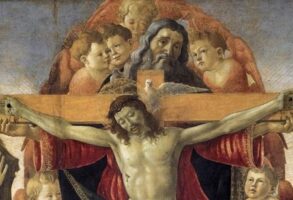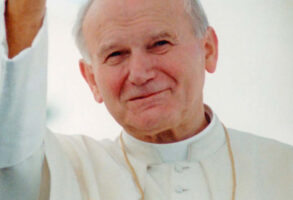Published April 22, 2015
On March 25, 2000, the media flap of the day in Jerusalem centered on the question of whether Pope John Paul II would wear his pectoral cross when he visited the Western Wall of the Temple — as he was being urged not to do by some activists. Wanting to help douse this particularly silly fire, I rounded up an old friend, Rabbi James Rudin of the American Jewish Committee, and invited him to spend a moment on MSNBC, in whose coverage of the papal visit I was assisting. Rudin was, as I had expected, pitch-perfect: “In serious interreligious dialogue,” he said “we begin by taking the other as he is, and we move on from there.” End of flap.
Off-camera, though, Jim Rudin told me a story I would have given gold and frankincense to have known when I was preparing the first volume of my John Paul II biography, Witness to Hope. It seems that there had been a similar flap during the preparations for John Paul’s historic visit to the Great Synagogue of Rome in 1986. Long a dream of the Polish pope, the visit had been made possible in no small part by the blossoming friendship between him and the chief rabbi of Rome, Elio Toaff. The chief rabbi, however, was under pressure from some of his more stringent congregants, who were demanding that he demand that the pope not wear his pectoral cross in the synagogue, where, according to custom, crosses were strictly forbidden.
Rabbi Toaff, looking to sort this out, went to see the pope, to whom he explained the synagogue’s custom and his difficult position. John Paul replied, in so many words, Look, if I were coming to your synagogue as a tourist I’d be happy to wear jeans. But the whole point of my coming is that I’m coming as the pope and the bishop of Rome. And, to make that point unmistakably clear, I have to dress as I always do.
Toaff went back across the Tiber and met with a delegation of the congregants who had been hassling him about papal vesture. What happened? they asked. I told him your concerns, Toaff replied. Then what happened? He and I are completely agreed, the chief rabbi said. The congregants smiled. Then Toaff said, point blank: “We agreed that he’ll dress as he always does.”
I thought of this wonderful vignette — a sparkling example of authentic interreligious dialogue and understanding, which, as Jim Rudin said, begins by taking the other as he is — when news came of Elio Toaff’s death on April 19, at age 99. I then remembered that, in his Spiritual Testament (a kind of papal will), John Paul II had explicitly thanked only two people for their friendship: his longtime secretary, now-Cardinal Stanisław Dziwisz; and Rabbi Elio Toaff. That says something about the depth of John Paul’s feeling for the man who made it possible for the pope to bear witness, in the Great Synagogue of Rome, that Jews were to Catholics as “our dearly beloved brothers” and indeed were, in the Christian view, “our elder brothers.”
John Paul II and Elio Toaff shared a vision of the Catholic–Jewish dialogue that went far beyond the necessary cleansing of memories and consciences, the clean-up of the detritus from a past riddled with prejudice and suffering — and worse. That was a necessary first step. But it was only a first step. Recognizing that Auschwitz was “the Golgotha of the modern world” (as John Paul II put it when he was there in 1979) — a singular monument to what happens when humanity forgets God — was absolutely essential. But it was not an end. It was only a beginning, for the next question was, and is: How shall we build barriers against such atrocities in the future?
John Paul II’s approach to Jews and Judaism was shaped by a distinctive conviction that I believe he shared with Elio Toaff — a conviction that was the basis of their friendship, and of their work together. Karol Wojtyła came to the papacy convinced that the world’s story and the biblical story are not stories running on parallel tracks. Rather, the biblical story — the story whose chapter headings in the Hebrew Bible are Creation, Fall, Promise, and Prophecy; the story Christians believe continues in the New Testament under chapters titled Incarnation, Redemption, Sanctification, the Kingdom of God — is the world’s story, rightly understood: the story whose surface features are conventionally labeled Ancient Civilizations, Greece and Rome, the Dark Ages, the Middle Ages, Renaissance and Reformation, the Age of Reason, the Age of Science, the Space Age, the Internet Age, and so forth. The biblical story is the world’s story read in its deepest dimension and against its most ample horizon. The biblical story is the story inside the conventional story of history, the depth story that gives the surface story its “narratability,” so to speak, and, ultimately, its coherence. Salvation history does not run on a parallel track to what is conventionally called “world history”; salvation history is world history read at its true depth and against its proper horizon.
Like Abraham Joshua Heschel and like Elio Toaff, John Paul II believed that the human story is not the story of man’s search for God, but rather the story of God’s search for us — and our learning to take the same path through history that God is taking, even today. That is what the biblical story teaches us. And that, John Paul II was convinced, is the story the world must learn anew (or, in some cases, for the first time), if the world is to recover (or discover) a sense of its nobility and possibility. In that conviction, John Paul II became a pilgrim to the world: a biblical pilgrim, telling the world its true story — the story of Abraham, the story of Moses, the story of Jesus — so that, as he put it at the United Nations in 1995, “a century of tears might give birth to a new springtime of the human spirit.” And on that pilgrimage, he was supported, in spirit and in friendship, by Elio Toaff and those who had come to understand what Rabbi Toaff understood: True interreligious dialogue begins with taking the other as he is, and moving on from there. Because true tolerance is not ignoring differences, but engaging differences within the bond of friendship and charity, so that both partners in the conversation are enriched by the “other” — who then begins to seem less “other.”
John Paul II frequently said that Jews and Christians should be a “blessing to one another”: another indicator of his conviction that Catholics and Jews ought to be talking not only about the pain of the past but about the possibilities of the future. But for what were we to be a blessing to one another? So that the world, in learning its true story, might recover its moral sanity. So that the peoples whose basic moral code comes from Sinai might be lights to the nations, witnesses to human dignity, and defenders of human life and human freedom. So that, together, Jews and Christians might remind the world that history is His-story, God’s story, and that our human dignity is ennobled, not diminished, by our taking the same path through history taken by the God of Abraham, Isaac, and Jacob, the God whom Jesus called “Father.”
John Paul II was playing for high stakes here: His goal was nothing less than to reconvene, after some 1,900 years, the dialogue about election and covenant, messianic hope and divine promise, the redemption of Israel and the redemption of the world, that had been tragically cut off, with grave historical consequences, during the First Jewish–Roman War: when, about 70 C.E., what became rabbinic Judaism and what became the Christian movement definitively divided in what is now known as “the parting of the ways.” Could that conversation be reconvened after almost 19 centuries? For John Paul II, though, the question was not “whether” but “how,” for the consequences of notreconvening the conversation about how both Christians and Jews can be lights to the nations would be a grave blow to the entire world. Elio Toaff agreed. So should anyone interested in the future of the West.
The new outbreak of virulent anti-Semitism in Europe and in parts of North America (think: Montreal) is, as Theodor Herzl understood more than a century ago, a sign that something is seriously awry in the moral culture of the West. When the fever chart of anti-Semitism spikes upward, it is always a sign that the patient — the West — is in mortal danger. And it is in danger in no small part because it has forgotten the biblical roots of the Western civilizational enterprise: for the foundational Western metaphor of freedom and human liberation is not the Enlightenment (and still less the French Revolution) but the Exodus, which both Jews and Christians recently remembered and celebrated at Passover and Easter. And the Exodus is a liberation completed by a moral code that is intended to help the newly free rid themselves of the habits of slaves — the bad habits that derive from willfulness and self-absorption.
So in rebuilding the spiritual and moral foundations of the West as an essential part of meeting the challenges posed by violent and irrational nationalism (read: Russia) and violent, irrational religious passion (read: jihadism) — challenges that will emphatically not be met by nihilism (read: Charlie Hebdo) and bullying in the name of a false notion of “tolerance” (read: recent events in Indiana) — what might the West in the 21st century learn from the encounter of John Paul II and Elio Toaff: two men who knew the agony of the 20th century in their bones and who rose above the temptations of retribution to sketch a different path into the future?
Christians might learn that a Christianity ignorant of the Old Testament and uninformed about living Judaism is an impoverished Christianity, severed from its roots and hence diminished in its spiritual life.
Jews might learn that the most doctrinally serious Christianity is the Christianity with which they can engage in dialogue, not the Christianity Lite that too often accommodates itself to the secular and skeptical Zeitgeist — and to the anti-Semitism that the spirit of the age often carries today, and justifies in the name of anti-Israel politics.
Christians and Jews might learn, together, that biblical religion reduced to cultural or ethnic habit cannot be the light to the nations that the children (and adopted children) of Abraham are called to be. And the world needs that light, amidst considerable darkness.
At the Great Synagogue in 1986, Saint John Paul II, standing beside his friend the chief rabbi of Rome, Elio Toaff, called Jews and Christians to “a collaboration in favor of man,” a collaboration in defense of human life and human dignity. If we would honor the memories of these two historic figures, Western minds, hearts, and souls must be committed to advancing that collaboration — and doing so on the basis of the truths that, as John Paul II put it at Sinai in 2000, were “written on the human heart” before they were “written in stone.”
— George Weigel is Distinguished Senior Fellow of Washington’s Ethics and Public Policy Center, where he holds the William E. Simon Chair in Catholic Studies.








